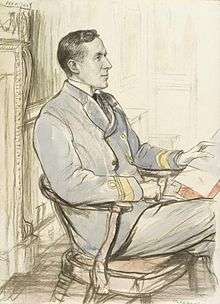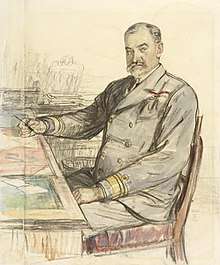Admiralty War Staff
The Admiralty War Staff[1] was the former senior naval staff operational planning organisation within the British Admiralty that existed from 1912–17. It was instituted on 8 January 1912 by Winston Churchill in his capacity as First Lord of the Admiralty[2] and was in effect a war council whose head reported directly to the First Sea Lord. After the First World War ended, the War Staff was replaced by the Admiralty Naval Staff department.[3][4]
 | |
| Agency overview | |
|---|---|
| Formed | 8 January 1912 |
| Preceding | |
| Dissolved | May 1917 |
| Superseding agency | |
| Jurisdiction | Government of the United Kingdom |
| Headquarters | Admiralty Building Whitehall London |
| Agency executives |
|
| Parent department | Admiralty |
History and development
The department's development can be traced back to 1885. It evolved out of some of the functions within the Naval Intelligence Department (NID), which originally administered two divisions: Foreign Intelligence Division and Mobilisation Division.
In 1900 a third was added, the War and Coast Defences Division, to deal with issues of strategy and defence. In 1902 a fourth function was added, the Trade Division, which was created for matters relating to the protection of merchant shipping.
The Trade Division was abolished in October 1909 in the wake of the Committee of Imperial Defence inquiry into the feud between the First Sea Lord, Admiral Sir John Fisher and former Commander-in-Chief Channel Fleet, Admiral Lord Charles Beresford, when it was discovered that the captain heading the Trade Division had been supplying the latter with confidential information during the inquiry.[5]
Following restructuring the NID was relieved of its responsibility for war planning and strategy when the outgoing Fisher created an interim Admiralty Navy War Council [6] as a stop-gap remedy to criticisms emanating from the Beresford Inquiry that the Navy needed a naval staff, a role the NID had been in fact fulfilling since at least 1900, if not earlier. After this re-organisation, war planning and strategic matters were transferred to the newly created Naval Mobilisation Department (NMD), and the NID reverted to the position it held prior to 1887, an intelligence collection and collation organisation.[7]
Sir John Fisher had made known his support for the need of a Naval Staff as early as 1902. In creating a staff the Admiralty was certainly lagging behind, particularly when the War Office had a General Staff department as early as 1904, to deal with the aftermath of the Boer War and an assessment of the problems they faced the Admiralty. However, at this point it had no Senior Staff department.
In May 1909, the Director of Naval Intelligence, Rear-Admiral The Honourable Alexander E. Bethell, submitted a proposal for a Navy War Council composed of the First Sea Lord as President, the Director of Naval Intelligence as Vice-President, an Assistant Director for War, the President and the Captain of the Royal Naval War College, and the Naval Assistant to the First Sea Lord. The head of the Naval Intelligence Department's War Division and the Commander of the Royal Naval War College were to act as Joint Secretaries.[8]
Establishment
In 1911, Winston Churchill, the First Lord of the Admiralty, communicated to the Prime Minister that the Admiral of the Fleet was opposed to any formation of a new naval staff, and because of this he insisted that he be relieved of his duties by January 1912. Churchill would continue to brief the Prime Minister as the project developed and advised him as to what the composition of the new staff department might initially entail:
- War Education Division
- War Information Division
- War Planning Division
- War Mobilisation Division
These divisions would be headed by a new Chief of the War Staff answerable to the Board of Admiralty and supported by an Assistant Chief of the War Staff. In January 1912, the First Lord released his communique detailing the administrative function of the new department and listed the following new appointments.
- Chief of the War Staff
- Director of the Operations Division
- Director of the Intelligence Division
- Director of the Mobilization Division
From 1912, onward additional divisions were established headed by directors responsible for their particular function.
At its founding, 12 officers were selected to undergo the new course of training for staff officer. Reginald Plunkett was the first officer selected.[2]
Duties
As stated in the Churchill Memorandum on a War Staff for the Royal Navy [9] Point 10: The functions of the War Staff will be advisory. The Chief of the Staff, when decision has been taken upon any proposal, will be jointly responsible with the secretary for the precise form in which the necessary orders to the Fleet are issued, but the Staff will possess no executive authority. It will discharge no administrative duties. Its responsibilities will end with the tendering of advice and with the accuracy of the facts on which that advice is based.
Disestablishment
In early spring 1917 the name "War Staff" was abolished and a replaced by an Admiralty Naval Staff. The First Sea Lord also assumed title of Chief of Naval Staff (CNS) and staff functions were grouped under two new heads, the Deputy Chief of the Naval Staff (DCNS) and the Assistant Chief of the Naval Staff (ACNS).
Chiefs of the War Staff
Chiefs of the War Staff included:[10]
| Rank | Name | Image | In office | Notes | Reference |
|---|---|---|---|---|---|
| Rear Admiral | Ernest Troubridge | January 1912 – January 1913 | [11] | ||
| Admiral | Sir Henry Jackson | January 1913 – July 1914 | [11] | ||
| Vice Admiral | Sir Doveton Sturdee |  |
July 1914 – November 1914 | [11] | |
| Admiral | Henry Oliver |  |
November 1914 – May 1917 | [11] | |
Assistant Chiefs of the War Staff
Assistant Chiefs of the War Staff included:[11]
| Rank | Name | Image | In office | Notes | Reference |
|---|---|---|---|---|---|
| Commander | Tufton Beamish | January 1912 – April 1913 | [12] | ||
| Captain | Arthur Vyvyan | January 1913 – October 1914 | |||
| Lieutenant colonel | John Rose, RMLI | September 1914 – October 1914 | |||
| Captain | Sydney Fremantle | September 1914 – July 1915 | |||
| Lieutenant colonel | Harry Farquharson, RM | October 1914 – March 1915 | |||
| Captain | Arthur May | May 1915 – January 1918 | |||
| Captain | Henry W. Grant | May 1915 – January 1918 | |||
Special Service, War Staff
Special Service, War Staff included:[11]
| Rank | Name | Image | In office | Notes | Reference |
|---|---|---|---|---|---|
| Vice Admiral | Sir Edmond Slade. | April 1915 – November 1918 | retired flag officer | ||
| Vice Admiral | Sir Douglas Gamble. | July 1915 – May 1917 | retired flag officer | ||
| Vice Admiral | Sir Robert Ommanney. | August 1915 - – November 1918 | retired flag officer | ||
| Captain | the Hon. Charles Dormer | July 1915 – November 1918 | |||
| Captain | Egerton Scrivener | July 1915 – November 1918 | |||
Operational divisions
As of December 1916, operational divisions included:[13]
- Anti-Submarine Division, formed in 1916
- Naval Intelligence Division, formed in 1912
- Operations Division, formed in 1912
- Mobilisation Division, formed in 1912
- Signals Section (Combined Operations), formed in 1916
- Trade Division, formed in 1914
References
- Black, Nicholas (2011). British naval staff in the First World War. Woodbridge: Boydell Press. pp. 15–52. ISBN 1843836556.
- "Obituary: Sir Reginald Plunkett-Ernle-Erle-Drax – First Director of the Naval Staff College". The Times. The Times Digital Archive. 18 October 1967. p. 12.
- Moretz, Joseph (6 December 2012). The Royal Navy and the Capital Ship in the Interwar Period: An Operational Perspective. Routledge. p. 247. ISBN 9781136340369.
- Archives, The National. "The Discovery Service". discovery.nationalarchives.gov.uk. National Archives. Retrieved 19 January 2017.
- Hurd, Archibald (1921). "The Merchant Navy". John Murray. Retrieved 7 November 2015.
- Kennedy, Paul (24 April 2014). The War Plans of the Great Powers (RLE The First World War): 1880-1914. Routledge. p. 128. ISBN 9781317702528.
- Strachan, Hew (2003). "The First World War: Volume I: To Arms". Oxford University Press. ISBN 978-0199261918.
- Harley, Simon; Lovell, Tony. "Navy War Council - The Dreadnought Project". dreadnoughtproject.org. Lovell and Harley, 2007.
- Churchill, Randolph S. (1969). Winston S. Churchill (Repr. ed.). London: Heinemann. pp. 1486–1490. ISBN 0434130087.
- Black, Nicholas Duncan. "The Admiralty War Staff and its influence on the conduct of the naval war between 1914 and 1918" (PDF). discovery.ucl.ac.uk. University College London, 2005. Retrieved 18 January 2017.
- Black, Nicholas Duncan (2005). "The Admiralty War Staff and its influence on the conduct of the naval war between 1914 and 1918" (PDF). discovery.ucl.ac.uk. University College London. pp. 236–237. Retrieved 19 January 2017.
- Great Britain, Admiralty (1912). The Navy List. H.M. Stationery Office. p. 100.
- Black, Nicholas Duncan. "The Admiralty War Staff and its influence on the conduct of the naval war between 1914 and 1918" (PDF). discovery.ucl.ac.uk. University College London, 2005. Retrieved 18 January 2017.
Attribution
Primary source for this article is by Harley Simon, Lovell Tony, (2017), Admiralty War Staff (Royal Navy), dreadnoughtproject.org, http://www.dreadnoughtproject.org.
Sources
- Black, Nicholas (2009). The British Naval Staff in the First World War. Woodbridge: The Boydell Press. ISBN 9781843834427.
- Harley, Simon and Lovell, Tony (2007).The Admiralty War Staff, dreadnoughtproject.org, Harley and Lovell.
- Naval Staff, Training and Staff Duties Division (1929). The Naval Staff of the Admiralty. Its Work and Development. B.R. 1845 (late C.B. 3013). Copy at The National Archives. ADM 234/434.
- "Proposals by Director of Naval Intelligence for carrying out the Duties of a General Staff and Re-organisation of the Naval Intelligence Department." 15 May 1909. The National Archives. ADM 1/8047.
- Rodger. N.A.M., (1979) The Admiralty (offices of state), T. Dalton, Lavenham, ISBN 978-0900963940.